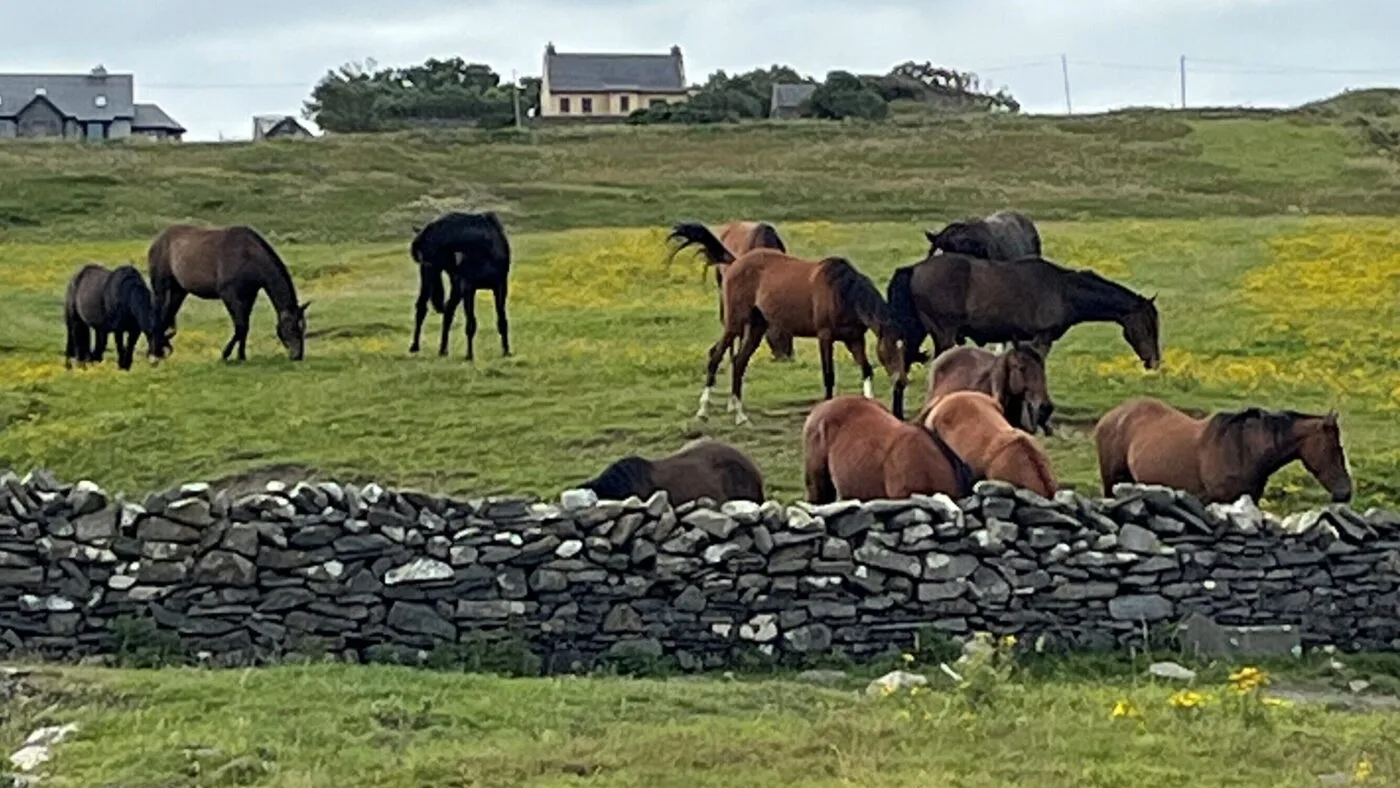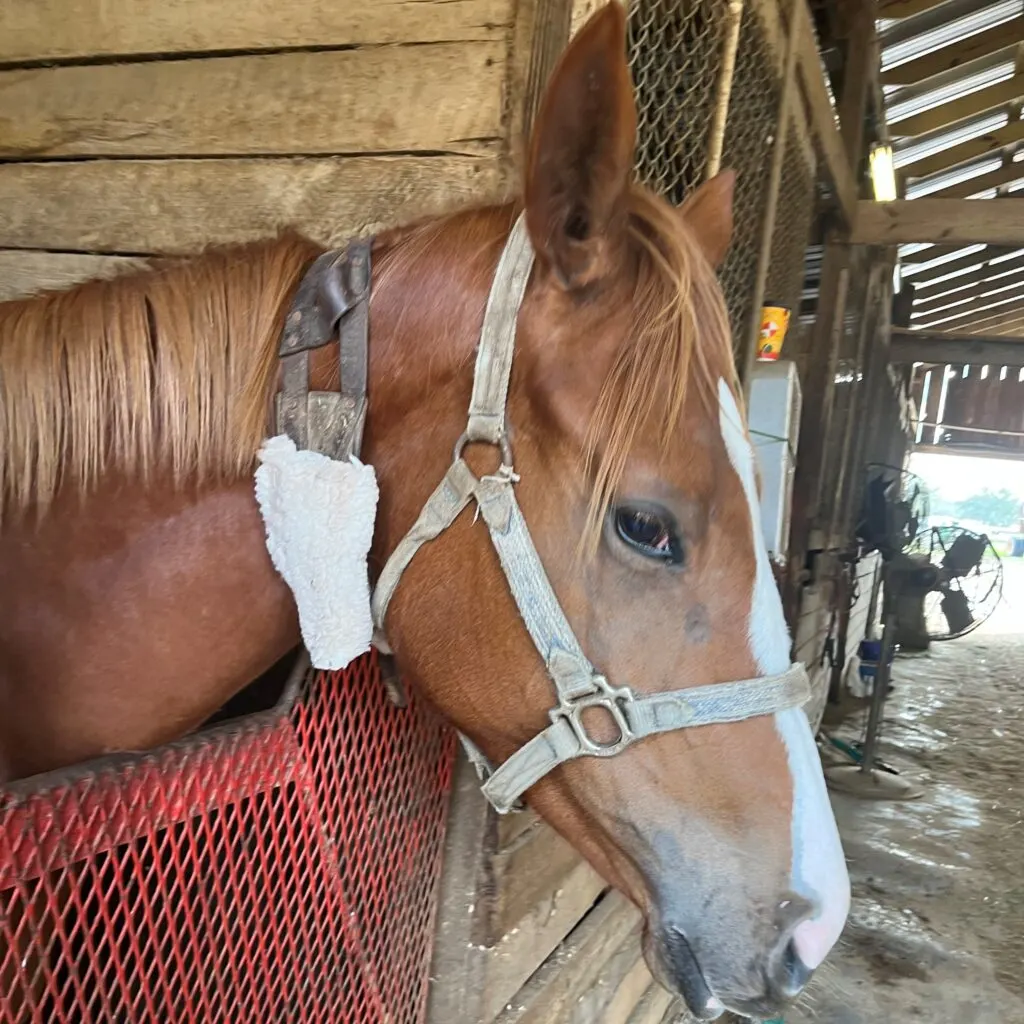Last updated: February 22, 2024
Any links on this page that lead to products on Amazon are affiliate links and I earn a commission if you make a purchase. Thanks in advance – I really appreciate it!
Did you know that up to 5% of horses display a behavior known as cribbing? This involves a horse biting on a solid object, such as a fence or stall door, and then pulling back while sucking in air. Cribbing is a compulsive behavior that is concerning for horse owners.
Having owned horses for years, including a few that were cribbers, I’ve witnessed firsthand the challenges it presents. Cribbing can lead to dental wear and digestive issues and can be a sign of underlying stress or discomfort, making it a significant concern for those of us dedicated to our horses’ well-being.

Understanding Cribbing
Cribbing might seem like a quirky habit, but it’s a behavior that tells us more about our horses than meets the eye. Let’s dive into what it really is, how our horses show us they’re cribbing, and why they might start this behavior.
What Exactly is Cribbing? Imagine your horse finding a favorite spot on the fence or stall door, gently biting down on it, then pulling back while taking a deep breath. That’s cribbing. It’s not just a habit; it’s a way for them to communicate their needs and feelings.
Spotting Cribbing in Your Horse:
- How Often? It varies. Some may crib occasionally, while others might seem to make it their full-time job.
- Where and What? They often have a go-to spot or object they prefer for their cribbing sessions.
- Visible Signs: You might notice their teeth looking worn, or they might seem a bit more distant, lost in their own world.
Why Do Horses Start Cribbing?
Cribbing in horses can be triggered by various factors:
- Feeling Stressed? Changes in their home, feeling lonely, or just not having enough to do can lead to stress cribbing.
- Boredom Strikes: Like us, horses need regular exercise and buddies to hang out with. Without these, boredom can lead them to crib.
- Stomach Troubles: Their diet plays a big role, too. Too much grain and not enough roughage can upset their stomach, making cribbing a go-to for relief.
- Genetic Predisposition: Research suggests that some horses might be genetically inclined to crib.
Discover the intriguing world of horse cribbing in this YouTube video.
Understanding Cribbing as a Stress-Relief Mechanism
Cribbing might look troubling, but it’s often a horse’s way of saying, “I’m stressed.” Here’s a quick dive into this behavior:
- Stress Buster: Research shows cribbing lowers heart rate and endorphin levels, signaling relaxation. A notable study in the Equine Veterinary Journal highlights this physiological response.
- Why They Start: Stress, confinement, and diet are big triggers. A study by A. J. Waters, J. Nicole, and P. French points out several factors increasing the likelihood of developing cribbing behaviors:
- Dominant mare foals? More prone.
- Weaned in confinement? Higher chance.
- Kept in barns post-weaning? Likely to crib.
- High concentrates in diet? Four times the cribbing.
- Ethical Dilemma: Balancing stress relief against health risks is crucial.
- Ulcer Relief: Cribbing can ease stomach ulcer pain by increasing saliva production.
Understanding the stress-relief aspect of cribbing is vital for horse owners and caretakers. It emphasizes the need for a compassionate approach to managing this behavior, aiming for a stress-free environment, balanced diet, and plenty of social time to reduce their need to crib.

Impact of Cribbing on Horse Health
Cribbing can have serious implications for a horse’s health. Here’s how this habit can affect our equine companions:
Dental Issues:
- Cribbing can lead to abnormal tooth wear, particularly on the incisors, which grip the surfaces they crib on. Over time, this can affect how a horse eats and processes food.
Colic:
- Studies have shown a correlation between cribbing and an increased risk of certain types of colic, such as epiploic foramen entrapment. The act of cribbing can lead to more air entering the stomach, which might contribute to gastrointestinal distress.
Weight Loss:
- The combination of dental wear and potential digestive issues can make it difficult for a horse to maintain a healthy weight. Affected horses might not absorb nutrients efficiently or may eat less due to discomfort.
Veterinary Insights:
Research in the Equine Veterinary Journal highlights that cribbing is not merely a vice but a sign that a horse might be trying to cope with stress or discomfort. Experts suggest that while we cannot always eliminate cribbing, understanding its underlying causes and addressing them can mitigate its health impacts.

Preventing and Managing Cribbing
Tips to prevent cribbing:
- Environmental Enrichment:
- Provide toys and various types of forage.
- Ensure opportunities for social interaction.
- Regular Exercise:
- A physically active horse is less likely to crib.
- Diet Management:
- Opt for a high-fiber diet and minimize concentrates.
- Minimize Stress:
- Maintain a consistent routine and environment.
Strategies to manage horses that crib:
- Physical Barriers:
- Use cribbing collars or muzzles appropriately fitted.
- Dietary Adjustments:
- Increase roughage and consider digestive health supplements.
- Behavioral Therapies:
- Employ positive reinforcement to encourage alternative behaviors.
- Stress Reduction:
- More turnout time and changes in the stable environment for comfort.

Case Studies and Expert Opinions
The Turnaround of Soldier Boy: My Thoroughbred Soldier Boy had a severe cribbing problem. We tried a few different things, including more turnout time, dietary changes, and behavioral training. Over six months, Soldier’s cribbing reduced significantly.
Addie’s Recovery: Addie, a Thoroughbred filly, showed signs of stress-induced cribbing. We worked closely with a veterinarian to address her underlying gastric issues and changed her stall so she could be around other horses.
Expert Opinions
- Veterinarian Insight: Our equine veterinarian emphasizes the importance of early intervention and a personalized approach to cribbing. He notes that understanding the individual horse’s history and environment is crucial in developing an effective management plan.
- Behaviorist Perspective: Equine specialist Eric Frenchy stresses the role of mental stimulation and social interaction in managing cribbing. He advocates for natural grazing, regular exercise, and social contact as key components in reducing the frequency of cribbing behaviors.

FAQs on Horse Cribbing
What is horse cribbing, and why do horses do it?
Horse cribbing is a behavioral condition where horses bite on objects and inhale air sharply. It’s often a response to stress, boredom, or dietary issues.
Can cribbing in horses be cured?
While curing cribbing can be challenging, it can be managed effectively through environmental enrichment, dietary adjustments, and sometimes medical intervention.
Are certain horse breeds more prone to cribbing?
Research suggests that breeds like Thoroughbreds and warmbloods may be more predisposed to cribbing, indicating a possible genetic link.
Conclusion: Cribbing Horses
Cribbing isn’t just a habit; it’s a horse’s way of dealing with stress, boredom, or discomfort. Recognizing why horses crib is key to both stopping it before it starts and managing it if it does. Remember, cribbing can lead to health issues like dental wear and colic, but with the right mix of environmental enrichment, proper diet, and regular exercise, we can prevent it.
For cribbers, combining physical barriers, diet tweaks, and behavioral therapies, while addressing underlying stress, shows our understanding and care. It’s on us to ensure our horses are not just healthy but happy, steering clear of the need to crib.

Call to Action
Your experiences and insights are invaluable to us and the wider horse-owning community. If you’ve faced cribbing behavior with your horses, we’d love to hear from you.
Share your stories, tips, and strategies for managing cribbing in the comments section below or on our social media platforms. Together, we can build a supportive network of knowledge that benefits our beloved equine companions.
Let’s connect and share our journey towards understanding and managing cribbing in horses.
Poll Question
Additional Resources
For further exploration and deeper understanding, consider the following resources:
- Books: “Equine Behavior: A Guide for Veterinarians and Equine Scientists” by Paul McGreevy.
- Websites: The Horse (thehorse.com) for up-to-date research and articles on equine health.
- Professional Contacts: American Association of Equine Practitioners (aaep.org) for expert advice and veterinary resources.
